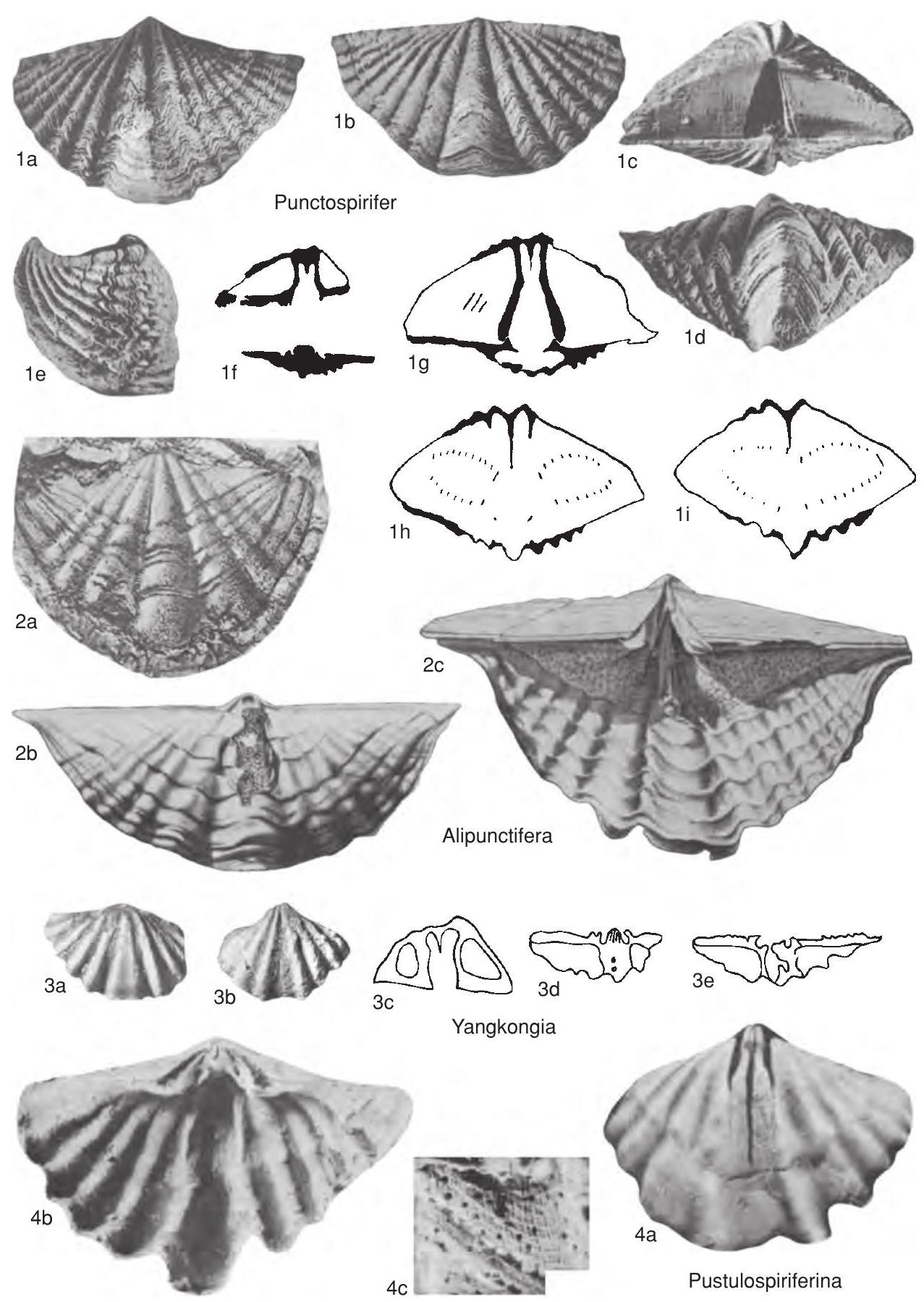Welcome to the Treatise on Invertebrate Paleontology!
Please enter a genera name to retrieve more information.

Punctospirifer
Classification
Phylum:
Brachiopoda
Subphylum:
Rhynchonelliformea
Class:
Rhynchonellata
Order:
Spiriferinida
Suborder:
Spiriferinidina
Superfamily:
Pennospiriferinoidea
Family:
Punctospiriferidae
Formal Genus Name and Reference:
Punctospirifer NORTH, 1920, p. 212
Type Species:
P. scabricosta, OD
Images
(Click to enlarge in a new window)
Fig. 1272, 1a-i. *P. scabricosta, Visean, England, a-e, ventral, dorsal, posterior, anterior, and lateral views, X2, f i, transverse sections, X1.5 (Campbell, 1959b).
Synonyms
Geographic Distribution
cosmopolitan
Age Range
Beginning Stage in Treatise Usage:
Upper Devonian (?upper Famennian), Carboniferous (Tournaisian)
Beginning International Stage:
Famennian
Fraction Up In Beginning Stage:
50
Beginning Date:
365.2
Ending Stage in Treatise Usage:
Carboniferous (Visean)
Ending International Stage:
Visean
Fraction Up In Ending Stage:
100
Ending Date:
330.34
Description
Small to medium size, outline variable, usually transverse, cardinal extremities subangular, rounded, or rarely slightly mucronate, fold and sulcus narrow to moderately wide, rounded, smooth or with single rib, often slightly flaring anteriorly, ventral interarea moderately high, weakly concave, usually apsacline, lateral slopes with moderately numerous strong, rounded plicae separated by narrow, subangular interspaces, growth varices irregularly spaced, microornament of closely spaced, imbricate growth laminae and fine, discontinuous capillae that rise and become wider with imbrications anteriorly as tiny U-shaped crenulations of lamellae in some species and sometimes terminating in minute, semierect pseudospines, dental adminicula short, slightly divergent, median septum long, high, slender, apical callus variably thick, ctenophoridium large, supported by short callus, dorsal adminicula absent or very short, adductors separated by long myophragm and bounded laterally in some species by low ridges, punctae moderately coarse, jugum probably absent.
References
Museum or Author Information
Classification
Phylum:
Brachiopoda
Subphylum:
Rhynchonelliformea
Class:
Rhynchonellata
Order:
Spiriferinida
Suborder:
Spiriferinidina
Superfamily:
Pennospiriferinoidea
Family:
Punctospiriferidae
Formal Genus Name and Reference:
Punctospirifer NORTH, 1920, p. 212
Type Species:
P. scabricosta, OD
Images
(Click to enlarge in a new window)
Fig. 1272, 1a-i. *P. scabricosta, Visean, England, a-e, ventral, dorsal, posterior, anterior, and lateral views, X2, f i, transverse sections, X1.5 (Campbell, 1959b).
Synonyms
Geographic Distribution
cosmopolitan
Age Range
Beginning Stage in Treatise Usage:
Upper Devonian (?upper Famennian), Carboniferous (Tournaisian)
Beginning International Stage:
Famennian
Fraction Up In Beginning Stage:
50
Beginning Date:
365.2
Ending Stage in Treatise Usage:
Carboniferous (Visean)
Ending International Stage:
Visean
Fraction Up In Ending Stage:
100
Ending Date:
330.34
Description
Small to medium size, outline variable, usually transverse, cardinal extremities subangular, rounded, or rarely slightly mucronate, fold and sulcus narrow to moderately wide, rounded, smooth or with single rib, often slightly flaring anteriorly, ventral interarea moderately high, weakly concave, usually apsacline, lateral slopes with moderately numerous strong, rounded plicae separated by narrow, subangular interspaces, growth varices irregularly spaced, microornament of closely spaced, imbricate growth laminae and fine, discontinuous capillae that rise and become wider with imbrications anteriorly as tiny U-shaped crenulations of lamellae in some species and sometimes terminating in minute, semierect pseudospines, dental adminicula short, slightly divergent, median septum long, high, slender, apical callus variably thick, ctenophoridium large, supported by short callus, dorsal adminicula absent or very short, adductors separated by long myophragm and bounded laterally in some species by low ridges, punctae moderately coarse, jugum probably absent.
